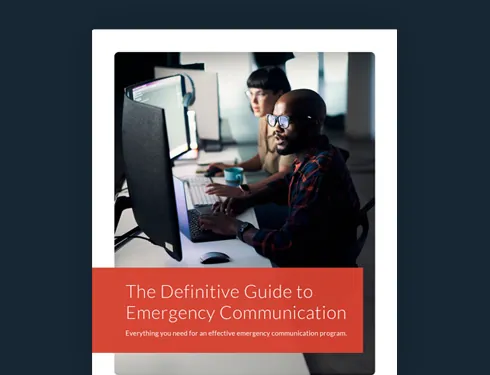
Manage Events With a Mass Communication System
Think a mass communication system is only capable of blasting out alerts to your employees? See how it can be used for event management and more.

Your Event Management Doesn’t Have to be so Hard
Company execs love to put on big, fancy events. They may invite business leaders, managers, partners, suppliers, stockholders, board members, customers, and maybe even regular employees who deserve a night on the house.
These events often take place in hotel ballrooms or conference centers with plenty of food, drinks, and entertainment. Speakers are given the stage, presentations, and short films often accompany, and most leave in a better mood than when they arrived (if it is done right). Events may be planned for product launches, annual conferences, holiday galas, or awards banquets. They are all a big deal, take a lot of time to plan, and cost a boatload of money.
If you pull back the curtain on these events, you’d find a team of employees working feverishly for months behind the scenes to get everything and everyone ready for such an occasion. The job is not easy. There are hundreds of moving parts and the planner likely loses a little sleep the night before. Everything must come together perfectly to put an event of this caliber on and make sure guests believe it was worth the tux rental to attend.
The Definitive Guide to Emergency Communication
Mass Communication System to the Rescue
Communications before, during, and after a large event is critical to its success. A mass communication system helps planners ensure every moving part is communicating with each other and with him or her so there are no surprises and no miscommunication.
Think of everything that goes into an event. The planner may come from inside the organization, maybe from marketing, event planning (if the organization is so lucky to have such a dedicated team), HR, or sales. Some organizations prefer to outsource the planning to professionals, yet even then, they will have to coordinate with someone or a group of people within the organization.
Beyond these event leaders, you have the people at the venue to manage. They may be responsible for setting up the location with chairs, tables, electricity, audio-visual technology, parking attendants, food and beverage stations, and check-in areas. Then there’s the caterer, beverage provider, servers, and bartenders. You may have presentations that need to be solicited and teed up with the tech crew. Lighting, speakers, sound. All of it must be managed by someone.
These are just a sampling of everything that goes into an event. Planning ahead of time takes countless emails, phone calls, texts, and probably a fair amount of frustration. During the event, it can be chaos for the planner trying to make sure everyone has done what they were supposed to do and is doing what they need to do, and of course, putting out countless fires. It makes me sweat just thinking about it.
A mass communication solution streamlines all of this chaos and makes event management much simpler. No, it can’t guarantee the chicken won’t be dry or there is enough ice, but it can help planners communicate more effectively with all of the contributors. When the curtain goes up, it’s no time to be running around trying to get people into their roles. A system can also engage guests before, during, and after the event to boost enjoyment and participation.
Event Management Made Easy
Using a mass communication system, planners can coordinate staff and volunteers over various communication channels, such as text, voice call, email, and even app push notifications. Instead of purchasing or renting two-way radios that have to be distributed and tracked, a mass communication system enables messages to be sent and received on the devices everyone already owns and uses, like a smartphone.
Using the system, contributors can be segmented based on their responsibilities. For example, one group can be designated in the system as the food and beverage group. The planner can choose to include the venue manager who may need to be in the loop on communications with caterers so they can ensure deliveries and set up go smoothly. The tech crew likely does not care about what the caterers are doing, so no need to subject them to every message the caterers get.
The system also enables real-time communications. During an event, it can save precious time to know you can reach any contributor in an instant on the device they choose to use. This multi-channel interaction capability is a huge improvement over traditional means and can be the difference between a complete fail and a crowning success.
Promote and Engage
A mass communication system can do more than coordinate events. It can help promote the event. When guests register for the event, they can opt in to receive event-based messaging and set their preferences as to which communication channel is best. Organizations can use the technology to then send event registration reminders and confirmations as well as event details, directions, and information, such as parking tips or weather notifications. Participants can opt-out at any time.
One of the coolest ways we’ve seen this type of communication system utilized is during the event. Silent auctions can keep guests updated as to what is up for bid, when bidding closes, if they won the bid, and where to pay for their items. Organized associations can notify their attendees of when special events are coming up, awards are being handed out, or promotions are happening.
I attended such an event not too long ago. The gala provided every guest with a temporary smartphone registered to them when they signed in. As guests perused the bid items, they used a custom app on the phones to select the item and input their bid amount. We were given a bid confirmation via a push notification. During the bid, we received push notifications as to how many others had bid on our item with a reminder that bidding would close at 10:00. Just after 10 P.M., we received another push notification letting us know we just bought a trip to the Dominican with a link to a payment page where I could input my credit card number. Brilliant.
Once the event is over, the system is still beneficial. It provides a simple way to conduct guest surveys to evaluate the success of the event. For event planners internal to the organization, knowing how well your efforts were received is valuable intel for the next go-round. You can receive real-time responses as well as reports with interactive feedback charts.
Build and Inform
An integrated communication system can also be effective at building stronger relationships with the guests, particularly if they are customers and prospects. When they opt-in to receive event updates, they just provided you with their best contact information, marketing gold. Organizations can seize the opportunity to engage with the guests beyond the event. Provide them with timely communications about upcoming events they may be interested in attending or relevant information based on what they may have learned at the event. In any instance, the organization has its foot in the door for ongoing communications with the customer. Remember, the customer always has the ability to opt-out if they are not interested in receiving these messages.
No matter how you plan an event, investing in a mass communication system should be at the top of your list of to-dos (sorry to add yet another). Even after the event is over, the system can be an integral part of your organization’s emergency notification process by providing a mechanism to reach your employees anywhere in the world with the messaging they need to hear (or see). The multi-channel platform lets businesses connect with employees on any or all devices in an instant.
The system just keeps on giving as it can also help companies with logistics, ensuring key personnel are where they need to be and can stay in constant communication with each other. Think of the system as the corporate megaphone, sending out key messaging to everyone and anyone that needs to hear it without the worry they won’t receive it.



![6 Steps to Creating an Effective Emergency Response Plan [+ Template]](https://www.alertmedia.com/wp-content/uploads/2023/10/Blog-Emergency-Response-Plan.webp)
